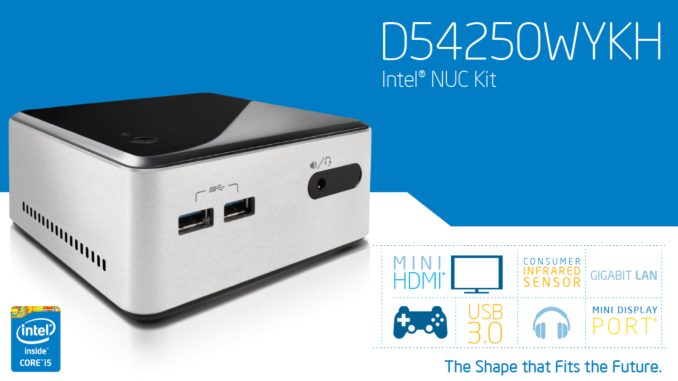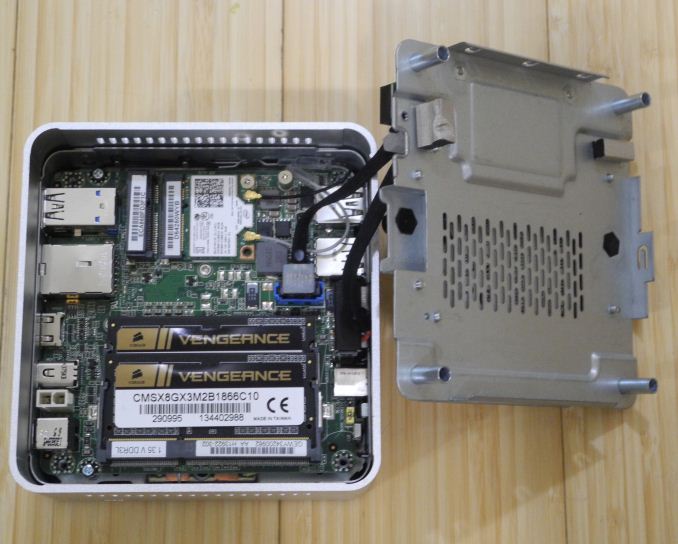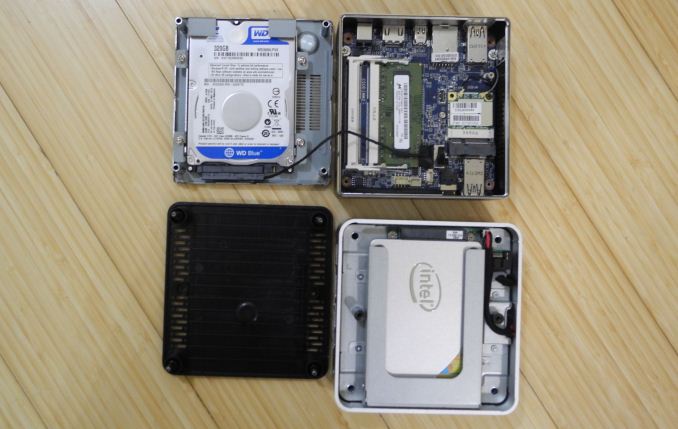Intel D54250WYKH Haswell NUC Kit with 2.5" Drive Slot Mini-Review
by Ganesh T S on May 18, 2014 10:15 AM EST
Introduction
The Intel NUC category has been an interesting product line to analyze, as it provides us with insights into where the traditional casual / home use desktop market might end up. This year, we have already reviewed two different NUC systems, the Intel D54250WYK and the Logic Supply Core ML320. The Intel D54250WYKH is fundamentally the same as the D54250WYK, except for the presence of a 2.5" drive slot. Since we have already looked at the performance of the Haswell i5 NUC platform in detail, this mini review will give us a chance to comment on the chassis redesign as well as an opportunity to see what different DRAM and storage can do to performance.
Inside the D54250WYKH:
In terms of external looks, the only difference between the D54250WYK and D54250WYKH are in the height of the system. Our D43250WYKH NUC kit came with an Intel SSD 530 240 GB 2.5" drive pre-installed. It could be accessed after removing the four screws holding the underside cover to the chassis.
While the Wi-Fi card (Intel AC-7260) that we saw in the D54250WYK review was present here too, we were free to choose the RAM this time around. Corsair came forward with a 8 GB Vengeance high performance DDR3L SODIMM kit capable of running at up to 1866 MHz with a CAS latency of 10 cycles.
Accommodating the 2.5" Drive:
Since the performance of the i5-4250U in the NUC board is quite well known (after two reviews), one of the important aspects that we cover in this review is the chassis modification for accommodating the 2.5" drive. For comparison purposes, we use a pre-production sample of the BRIX H-series PC (this is the standard BRIX board with the chassis slightly redesigned to accept 2.5" drives up to 9mm in height. The internal layout of the support for the 2.5" drive in both the versions is visible in the picture below.
While Gigabyte has opted to mount the drive bay flush against the chassis lid, Intel has a metal contraption on top of the motherboard in which the drive bay is integrated. The gallery below gives a closer look at both the designs. The first three pictures show the BRIX H design where the SATA data and power pins are brought out from the board to interface with a thin horizontal connector cable. This type of cable used to be popular during the netbook era (and even now, in notebooks such as the Razer Blade Pro). At the other end of the connector cable, we have a breakout into the standard SATA data and power connector for interfacing with the disk drive (as shown in the top segment of the photograph above).
The last three photographs in the gallery above show the Intel approach. Since the NUC board has separate SATA data ports and power connectors on the motherboard, Intel is unable to provide a clean solution to the problem of interfacing with the 2.5" drive. In the first of the Intel NUC photos in the gallery above, we have the power connector on the top metal layer visible. We can follow this to the SATA power connector on the main board by unscrewing the metal layer. This also provides us with a look at the SATA data cable which connects to a similar slot on the metal layer. All these results in the height of the chassis being more for the D54250WYKH compared to the BRIX H model. It is also not a surprise that disassembling the BRIX H to install a new drive / mSATA SSD / RAM is much easier than doing the same on the NUC chassis with the 2.5" drive slot.
In the rest of this review, we will have a few sections presenting various benchmark results (including wireless and storage system evaluation numbers). A section on power consumption and thermal performance precedes the concluding remarks. However, prior to all that, we have a table presenting the details of various systems that are compared against the D54250WYKH in this review.
| Comparative PC Configurations | ||
| Aspect | Intel D54250WYKH | |
| CPU | Intel Core i5-4250U | Intel Core i7-3720QM |
| GPU | Intel HD Graphics 5000 | Intel HD Graphisc 4000 |
| RAM |
Corsair Vengeance CMSX8GX3M2B1866C10 10-10-10-32 @ 1866 MHz 2x4 GB |
Super Talent W1333SB4GH 9-9-9-24 @ 1333 MHz 2x 4GB |
| Storage |
Intel SSD 530 Series (240 GB, 2.5in SATA 6Gb/s, 20nm, MLC) |
Intel® SSD 330 Series (60 GB, SATA 6Gb/s, 25nm, MLC) |
| Wi-Fi |
Intel Dual Band Wireless-AC 7260 (2x2 802.11ac - 867 Mbps) |
N/A |
| Price (in USD, when built) | $671 | $1300 |
























36 Comments
View All Comments
osamabinrobot - Sunday, May 18, 2014 - link
I just built this unit for myself at work and have been digging it.kgh00007 - Sunday, May 18, 2014 - link
Just some further information for anyone looking to buy one of these.This nuc can actually run 2133MHz RAM (G.Skill Ripjaws) and the TDP can also be increased in the bios or using the Intel Extreme Tunig Utility. Its possible to increase the TDP from 15W to 25W or 30W by adjusting the Sustained Mode Power Limit in the bios. This can also be done dynamically with the Intel XTU and be set to load different TDP's on a per app basis.
This is pretty cool and improves gaming on the nuc considerably as it allows the iGPU to sustain higher clocks. Temps remain the same, around 80degC, but the fan noise does increase a lot as the fan ramps up. I have it set to increase the TDP to 25W for games but to remain at 15W the rest of the time. As far as I know only the i5 versions of the nuc have these adjustments.
I'm really happy with my nuc hooked up to the living room TV, its an awesome little machine.
And mine did come with a power cord!
Aikouka - Sunday, May 18, 2014 - link
Amazon actually has a toggle to switch between units with and without a power cord. When I bought my first i3 Haswell NUC, it came without a power cord, but Amazon was rather generous in giving me a partial refund on it, which was more than enough to buy a cable.ganeshts - Sunday, May 18, 2014 - link
Thanks for the extra info. Pretty sure readers would love to experiment with this feature. To be frank, I wasn't even aware of this and Intel never advertised in their briefings / brochures.kgh00007 - Tuesday, May 20, 2014 - link
No worries!skiboysteve - Monday, May 19, 2014 - link
Wow I am doing this for sure. I have my NUC in a very loud industrial rack.MonkeyPaw - Monday, May 19, 2014 - link
I have an i5 Haswell Yoga 2, and it even has a "dust cleaning" mode. I haven't had to use it, but my guess is it ramps the fan up to clean out the cooling area. Pretty nice if it actually works.extide - Monday, May 19, 2014 - link
Typically dust cleaning modes actually run the fans in reverse for a little while.SeanFL - Sunday, May 18, 2014 - link
Built one of these a couple months back for audio editing and it works great. Quite pleased with the performance and the size is amazing. Went with the Samsung 840 evo msata on a recent build and it's even more impressive.Aikouka - Sunday, May 18, 2014 - link
Ganesh, what Wi-Fi drivers did you use? I'm curious because I own two i3 NUCs, and while I use the same Intel card in both and the same router (FW V1.0.3.24_1.1.20), the performance is awful. It only connects via 802.11n, and while the performance might be alright for a bit, it usually degrades into 1-5Mbps -- but it doesn't actually transmit anything. I've been tempted to try different drivers, but I just end up getting annoyed by the whole thing and plugging in an Ethernet cable. =POn that note, I have noticed some odd issues with the Nighthawk. For example, I use a rather awkward generated password for my WiFi, and I don't feel like typing it in on devices like a PS Vita or a 3DS. So, I use WPS to set it up. Unfortunately, WPS on the Nighthawk seems to wreak havoc on the router's WiFi system as it just becomes incredibly unresponsive after using WPS.